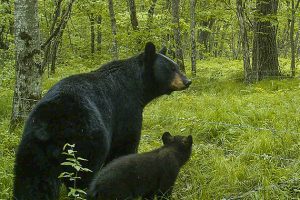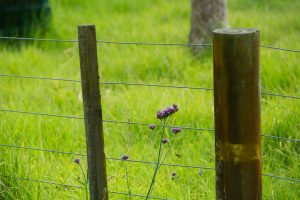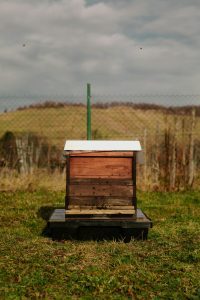Protecting Beehives from Bears
Author: Tracy Rittenhouse and Stacey Stearns
Tracy.rittenhouse@uconn.edu
Reviewer: Sara Tomis, UConn Extension
Publication EXT119 | May 2025
Whether you're a hobbyist or a professional beekeeper, one thing is certain: bears love honey. They’re also drawn to other food sources like apples and

pumpkins, especially during the fall. The right precautions can protect your bees and keep bears at bay. This fact sheet is for beekeepers and shares some important tips to help protect hives from bears.
Connecticut is home to black bears, and the population is widespread throughout the state, with an estimate of 1,200 in the state in 2025. They are most active in the spring, when they are waking up from hibernation, and females have cubs to feed. Fall is another active time for black bears, as they bulk up heading into their hibernation. Black bears are omnivores and enjoy high-calorie foods including honey, fruits, and vegetables.
Electric Fences
Setting up a bear-resistant electric fence around hives is first and foremost. This is the single most effective way to keep bears out. Bears are curious and
persistent, but they won’t risk a painful shock for honey. The fence should completely surround the apiary. The height of a bear is in its torso; bears have short arms and legs, therefore when bears are on all fours, they are shorter than most people realize. It’s important to have a wire at or below knee height, because knee height is nose height for most bears.
Make sure the electric fence is always charged, regularly tested, and there aren’t any trees or other objects the bear could climb to get over the fence. Position additional electric strand wires so they cover the other key heights, one close to the ground, one around the height of a bear’s nose, and additional wires evenly spaced in between. Proper electric fence grounding, through a metal grounding rod, placed five feet deep in moist soil, is key to making sure the fence works when you need it most.
The fence should be constructed using sturdy fenceposts, preferably those set in the ground. At a minimum, the corner posts should be set in the ground, with sturdy wooden posts that are braced. Don’t use a tree as a fence or corner post, as bears will use the tree to climb over the electric fence. Place additional fenceposts every twelve feet, depending on the size of the enclosure. Choose a strong wire and run strands around the hives at the following heights: 4, 16, 26, and 36 inches. All strands should be tight, and not sag in any area.
A 3,000-volt charge is enough to deter bears, and the fence should pulse every 45 seconds. Keep a voltage tester and check the fence output regularly.
Solar and battery fence chargers are available; there are advantages and disadvantages to both. Solar chargers will continue working despite a power outage; however, they may lose their charge during overcast or rainy weather.
Be sure to check whichever option you choose regularly to ensure it works. Finally, clear any grass, brush, or branches from the electric fence as these will ground the fence out and make it ineffective. Check the fence regularly and continue mowing and removing any grass and debris.
Traditional fencing is an option too; however, bears can climb most fences. Bears readily climb over chain link fence and wooden fences.
Placement of the Hives
Beyond fences, make sure the hives are placed in an open area with good visibility. Bears are not fond of sitting in the open, and prefer lots of food in one
location, such as an apiary located next to an apple tree. In other words, bears are more likely to target hives located near fruit trees or gardens full of pumpkins or other crops. So, if you have apple trees or vegetable gardens, try to keep them away from your apiary or remove fallen fruit quickly to avoid attracting bears. Bears love those seasonal snacks.
Personal Safety First
In some cases, you may find a bear attacking your hives, instead of just the after-effects. Always prioritize your personal safety first. Remain calm, and back away slowly, do not run and do not turn your back on the bear. Speak calmly in a low tone as you back away. If the bear approaches, stand your ground and wave your arms. Bear spray is useful if easily accessible and the wind direction is towards the bear.
Report property damage including damaged apiaries to the Connecticut Department of Energy and Environmental Protection at https://portal.ct.gov/deep/wildlife/fact-sheets/black-bear.
Whether you’re a backyard beekeeper with a couple of hives or a professional with many, protecting hives from bears doesn’t have to be difficult. A little planning and managing of nearby food sources can go a long way in keeping bees safe. Bears are smart and resourceful; they will eat a wide range of foods and can find other insects within the forest when an electric fence keeps them away from an apiary that you are protecting.
Resources
Maine Department of Inland Fisheries and Wildlife. (n.d.). Preventing conflicts with black bears: Beehives. https://www.maine.gov/ifw/docs/Preventing-bear-conflicts-beehives.pdf
Massachusetts Division of Fisheries and Wildlife. (n.d.). Protect your chickens, bees, livestock, crops and orchards from black bears. https://www.mass.gov/info-details/protect-your-chickens-bees-livestock-crops-and-orchards-from-black-bears
Michigan State University Extension. (2020, June 15). Keep your bees safe from bears. Michigan State University. https://www.canr.msu.edu/resources/keep-your-bees-safe-from-bears
Mid-Atlantic Apiculture Research and Extension Consortium. (2010, October). Bees and bears: A guide to preventing bear problems at apiaries (MAAREC Publication 4.8). University of Delaware. https://canr.udel.edu/maarec/wp-content/uploads/sites/18/2010/05/Bees-and-Bears-revision10-24.pdf
Vermont Fish & Wildlife Department. (n.d.). Bearproofing beehives. https://www.vtfishandwildlife.com/sites/fishandwildlife/files/documents/Learn%20More/Living%20with%20Wildlife/Living%20with%20Bears/Bearproofing_Beehives.pdf
The information in this document is for educational purposes only. The recommendations contained are based on the best available knowledge at the time of publication. Any reference to commercial products, trade or brand names is for information only, and no endorsement or approval is intended. UConn Extension does not guarantee or warrant the standard of any product referenced or imply approval of the product to the exclusion of others which also may be available. The University of Connecticut, UConn Extension, College of Agriculture, Health and Natural Resources is an equal opportunity program provider and employer.


